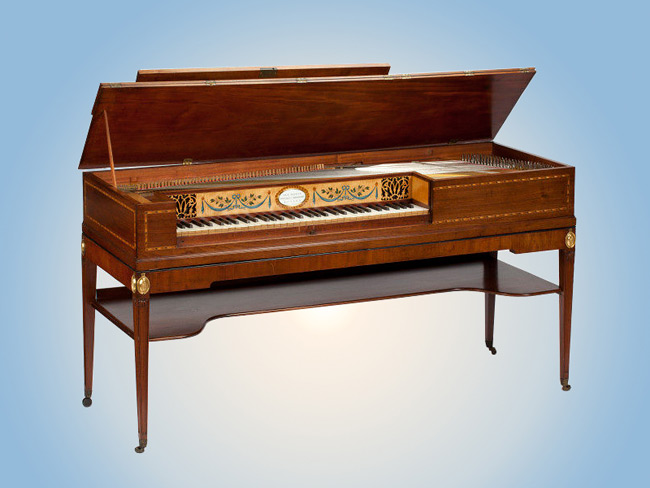|

Description
Piano with sixty-eight notes, FF-c4, chromatic, with simple rectangular mahogany case and stringing of various woods, standing on four square tapered legs, joined by a large mahogany shelf near the top of the legs. The nameboard is veneered in satinwood, with pierced fretwork at both ends, and swags of drapery with sprigs of foliage flanking an elypitical enamel plaque, set in a wreath and placed in the centre.
Place of Origin
London, England (made)
Date
ca. 1795 (made)
Artist/maker
Longman & Broderip, John (Longman) and Francis (Broderip) (maker)
Materials and Techniques
Mahogany case with stringing of various woods, partly painted satinwood veneered nameboard with pierced fretwork and enamel name plaque
Dimensions
Length: 165.6 cm, Width: 59.4 cm, Height: 22.6 cm Height of piano without its stand, Height: 85.5 cm Height of piano on its stand
Descriptive line
English square piano, solid mahogany case, satinwood-veneered nameboard, Longman & Broderip, about 1795.
Bibliographic References (Citation, Note/Abstract, NAL no)
Howard Schott: Catalogue of Musical Instruments in the Victoria and Albert Museum - Part I: Keyboard instruments. (London, 1998), p. 39
Labels and date
SQUARE PIANO
English
By Longman & Broderip, about 1795
Inscribed New Patent Longman & Broderip / London
Case of mahogany.
The instrument's range is sixty-eight notes, FF - c4, chromatic, and it has an English single-action.
Keyboard catalogue No.: 39
The 'square piano' was the earliest version of small piano, an instrument that became increasingly popular after about 1770. Its name is a translation of the French term piano carré. This example has no pedals or levers to vary the volume, but it was fitted with a large shelf for storing music. John Longman formed a partnership with Francis Broderip in 1775, which went bankrupt in 1798. To judge from the style of decoration, this undated piano was probably made in about 1795.
.jpg)
.jpg)
.jpg)
.jpg)
|
